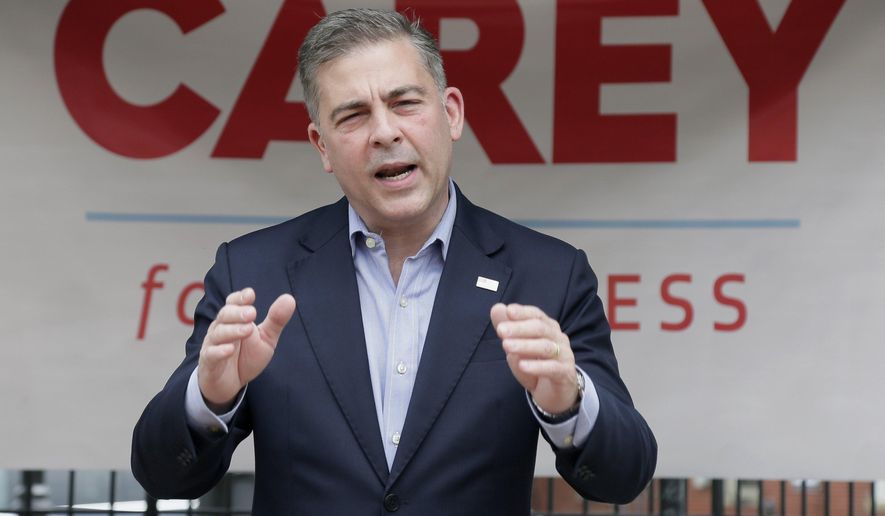Two special primary elections in Ohio on Tuesday signal that both President Biden and his GOP predecessor, Donald Trump, are still the leaders of their respective parties.
The two contests — one in a deep blue congressional district, the other in a solid red seat — saw allies of both men elected.
In the Republican primary for Ohio’s 15th congressional district, Mike Carey beat out 10 other candidates for the nomination. Mr. Carey, an energy executive, scored a double-digit win, despite being a relative unknown with Mr. Trump’s backing.
“Republicans across Ohio’s 15th Congressional District sent a clear message to the nation that President Donald J. Trump is, without a doubt, the leader of our party,” Mr. Carey said. “I could not be more grateful for his support, and I am proud to deliver this win to advance his America First agenda.”
The district fell open when former GOP Rep. Steve Stivers resigned to accept a position as president of the Ohio Chamber of Commerce. Mr. Stivers, who held the district for over a decade, backed a local state representative to run in his place.
Mr. Carey, however, upset those plans. Running as a political outsider and businessman very much in the mold of Mr. Trump, he took the race by storm after receiving a late endorsement from the former president.
Overall, Mr. Carey won 11 out of 12 counties in the congressional district, running up numbers in both the suburbs and rural areas.
In the lead-up to election day, the race was pitched as a test of Mr. Trump’s sway over Republican voters. Many were quick to question whether the former president’s political brand had diminished, after his endorsed candidate for a Texas congressional seat was defeated last week.
“The mainstream was chomping at the bit to report a loss for a Trump-endorsed candidate — they couldn’t wait,” Mr. Trump said in a statement. “But lo and behold, instead of a loss, there was a landslide victory for Mike — a win far larger than even the most optimistic of polls.”
Mr. Trump dismissed rumors about his diminished support, pointing out that the Texas special election was between two Republicans, each of whom had run as a supporter of his policies and brand of conservatism.
“My endorsed candidate won in the primary, but the other outstanding candidate won the general election because virtually 100% of Democrats … supported the candidate I did not endorse,” said Mr. Trump. “I won because we ended up with a great Republican candidate —the Democrats never had a chance. Unfortunately, the fake news never wrote that Democrats were in the race, obviously voting against me.”
Similarly, the results from the Democratic primary for Ohio’s 11th congressional district boosted Mr. Biden’s political standing. In that contest, Shontel Brown ran as an avowed ally of the president and scored a political upset by beating back a better-known challenger.
The race took on national proportions, becoming a proxy fight between the far-left and the establishment. The battle lines revived the lingering tensions that have existed among Democrats since 2016, when Sen. Bernard Sanders of Vermont challenged establishment favorite Hillary Clinton for the presidential nomination.
“It’s time that the political classes got the message,” said Matt Bennett, the executive vice president of the moderate Democratic think tank, the Third Way. “Democratic voters want bold, principled, pragmatic leaders who can beat Trump Republicans and work with the Biden team to deliver big things for America.”
Ms. Brown’s leading challenger was Nina Turner, a former Ohio state senator who first came to prominence in 2016 as a top adviser and surrogate on Mr. Sanders’ White House bid.
During that election cycle, her advocacy of progressive values even drew an offer from the Green Party to run as its vice-presidential nominee.
In 2020, Mrs. Turner again played a leading role in Mr. Sanders’ campaign. When the senator dropped out, Mrs. Turner drew attention for her criticism of Mr. Biden. In one particular interview with The Atlantic, Mrs. Turner compared voting for then-the Democratic nominee to “eating a bowl of s—-.”
The comments, as well as Mrs. Turner’s calls for conditioning aid to Israel, hurt her in the contest. Political action committees and advocacy groups associated with the Democratic establishment flooded the 11th congressional district with negative ads highlighting Mrs. Turner’s divergence from Mr. Biden and mainstream Democrats.
J. Miles Coleman, an elections analyst at the University of Virginia’s Center for Politics, said that Mrs. Turner’s strong affiliation with the progressive movement played a direct role in her defeat.
“Almost ironically in any other district in Ohio, that may have been an asset,” said Mr. Coleman. “But what may have hurt her, in the end, is that in the 2016 Democratic primary, the 11th was Hillary Clinton’s best district in Ohio. This was probably the worst district in Ohio to attach your name to Bernie Sanders.”
In winning the nomination, Ms. Brown ran a campaign very similar to Mr. Biden’s 2020 primary bid. She ran as a “consensus builder,” but one not afraid to stand up for liberal priorities.
Ms. Brown bested Mrs. Turner among suburbanites, and relied heavily on upper-middle-class voters. While both candidates pulled about even with Black voters overall, Mrs. Turner dominated with the urban upper-income White voters that proved a staple of Mr. Sanders’s two presidential campaigns.
“In these urban areas, you have this White liberal bloc of urban progressives that are increasingly going for more stridently liberal candidates,” said Mr. Coleman, “while the more heavily minority districts tend to go to the ‘establishment’ Democrat.”
He added, “I think what may have come to hurt Turner is that the backbone of the Democratic party is not white liberals, it’s still black voters. If you’re in good standing with those voters, it helps … this is Biden’s Democratic Party.”
• Haris Alic can be reached at halic@washingtontimes.com.




Please read our comment policy before commenting.